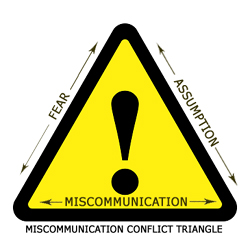 Miscommunication can be a costly occurrence.
Miscommunication can be a costly occurrence.
Defined simply by Merriam Webster as failure to communicate clearly, the causes of miscommunication can vary – lack of forethought or preparation, poor verbal skills or intentional deceit on the part of the sender; lack of comprehension, poor listening skills or distraction on the part of the receiver.
Author and conflict resolution expert Tristan Loo suggests that miscommunication is also the primary contributing factor to conflict.
“Miscommunication opens up the triangle of other factors that inevitably leads to conflict,” he said.
Loo went on to explain that people tend to fear the worst outcome.
In miscommunication the mind will fill in missing information with its own creative insight, which is often fear-based. Our minds naturally seek logical explanations to events as well. Absent those explanations, our minds frequently switch to a fear-based mode in which we satisfy our need for answers with that of assumption.
Once we lock-into our assumptions the tendency is to believe them as truth, thus resulting in conflict.
The Solution – “Real-time” Feedback
To bridge the gap, Loo suggests people adopt an open mind with respect to alternative possibilities. One way to facilitate this is to make effective use of clarifying or confirmation questions during conversations, business meetings, interviews, sales calls, assessments, or presentations, which can help us to avoid making the wrong assumptions.
The simple objective is to gather “real-time” feedback from those with whom we’re communicating, with a focus on three simple things:
- Are they understanding what we’re saying?
- Are they receptive to what we’re saying?
- Are we understanding what they’re saying?
Since it is an accepted principle that the primary sender of communication must take the responsibility for the quality of the communication, then the person who is leading the interaction should be the one to initiate these clarifying questions.
In the selling world, these types of questions are called “trial closing” questions; unlike closing questions, which are geared toward seeking decisions, the “trial closing” questions are instead used to seek opinions. When properly used, these simple questions will confirm both understanding and receptivity.
- “What do you think so far?”
- “Would that be helpful?”
- “Thoughts?”